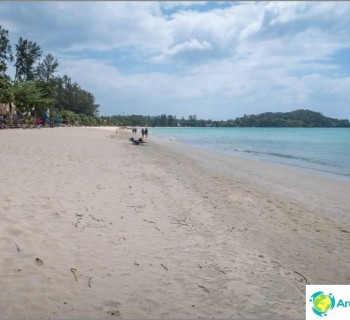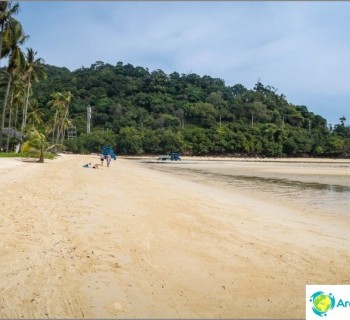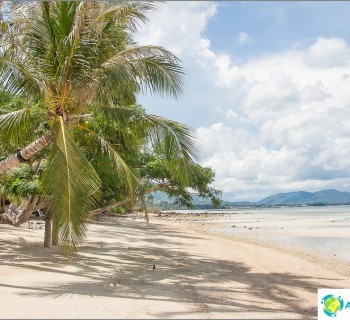This post will contain my impressions and information, that is, without a story about the concentration camp in Auschwitz itself (I don't know if this is necessary at all) and what happened there. There will also be few photographs. So you can read this post calmly, there is nothing heavy in it..
But a little later, I will separately post photos of the concentration camp (or rather, two concentration camps) in another post, so they are impressionable, perhaps not worth looking at. Although, of course, photographs are not quite right ... I recommend you go on your own if you find yourself in Poland or somewhere nearby.
The content of the article
Impressions from the concentration camps
Initially, it was Daria who really wanted to get to Auschwitz, because for no reason she began to be sharply interested in this topic after she saw The Berlin wall. For several years now this interest has not disappeared, therefore it is she who knows much more than me in this matter. Unfortunately, in time she managed to go only to Majdanek (closer to Warsaw, where we lived then), and I went to Auschwitz. It was impossible to miss such an opportunity, especially since I am rather indifferent to ordinary attractions, but here is a trip with meaning.
Moreover, the meaning is likely to be different for everyone. The official version says that about 1.4 million people were killed in Auschwitz. Just think about this figure, this is the population of a rather large city, or several small ones, including the elderly and children. A concentration camp is the quintessence of human cruelty, a place that can only be invented in a fevered imagination, a place that defies understanding ... Therefore, for some, a visit to Auschwitz will be a reboot, for others it is just an unusual attraction. One thing is clear, it will leave few people indifferent and will not make them think about something, well, if, of course, a person voluntarily came here.
To be honest, I had slightly different expectations from visiting a concentration camp. I thought that it would cover me there, reboot, I would understand something very important, or something else like that would happen. However, nothing. Some other visitors were crying (mostly women), but I have nothing inside, emptiness. That is, with my head I understood how terrible what had happened, but it was once upon a time, thank God, not with me and in general, it does not concern me. Probably, the apparent cheerful sun on the blue sky, warm weather, crowds of tourists with guides, creating an atmosphere of carelessness, guards, inspiring safety, had an effect. But personally, it was rather hard for me to feel what happened here. They say it is simpler in Majdanek, because there are few people there, and flocks of crows fly everywhere, escalating the situation, you can imagine. However, the trip remained in my memory for a long time, various pictures still pop up in my head and from time to time there is a desire to read something about the camp.
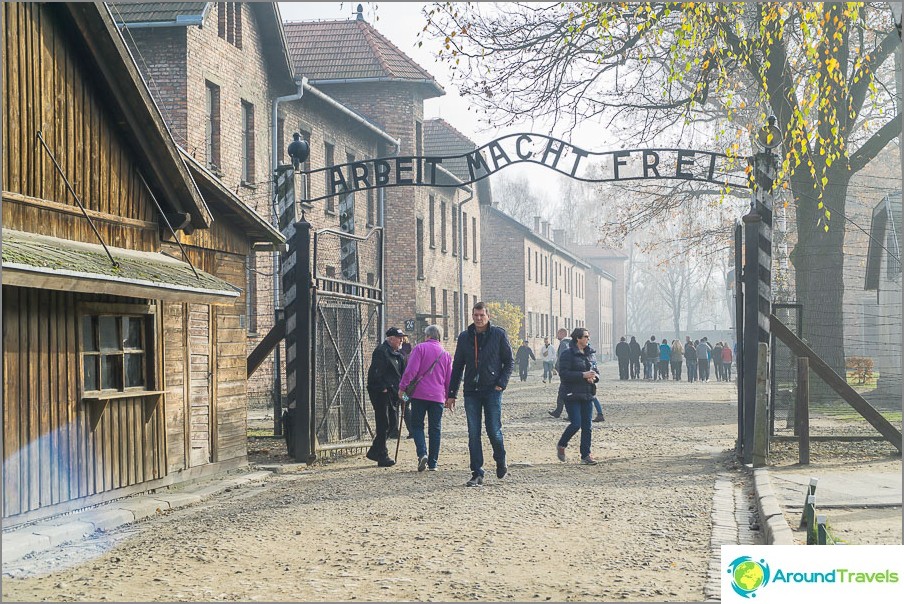
Lots of people, good weather. Auschwitz 1.
But you know, I didn’t even want to admit the thought that suddenly I’ll stay here now, and the past will return, from such thoughts it becomes scary and I want to drive them away. Before the closure of the museum, when it was almost dark, I found myself alone near one of the barracks (on the outskirts), then I could not go into it, somehow I felt uneasy. This I mean that there is some kind of internal protest for full immersion. That is, I do not know how you can fully admit this in general, how you can take and admit the reality of what happened, how you can believe in it and try on yourself.
Nevertheless, when you look at some thing of a prisoner, for example, a fork, the thought begins to spontaneously spin the plot. That this thing was used by a specific real person, he had a family, he had experiences, he had plans for the future, he wanted something and dreamed of something, he had a life in the end. And then, once, and there is nothing, it was crossed out at once, and there was only a desire to survive, most likely not fulfilled. Behind each such subject is the history of human life, and sometimes more than one.

On the site of one of the barracks, what was preserved in the ground
On the other hand, is it necessary to plunge so deeply? Yes, and is it possible in principle? Maybe it's enough just to come, see, draw some conclusions for yourself (even if logical) and return home? Do not know. Ultimately, one cannot live with a constant eye on how it happens, what is more important is what is now. Ideally, you need to learn to live, being able to appreciate what is, even small, but at the same time strive to set goals in relation to your current situation, and not how it could be in the worst case.
I will not tell historical data, about gas chambers with crematoria and so on, all this is enough now on the network (maybe I will add it later), so I will just give links to my photos from the trip. It also makes sense to say that there are those who deny the Holocaust. But for me, in any case, a lot of people died in concentration camps (the nation is not principled) and they survived there in inhuman conditions, this alone is enough to talk about it, remember, and conduct excursions for the edification of future generations.
Information to visit
Of site in English
The names Auschwitz, Auschwitz, Birkenau
To avoid confusion, I will tell you the main thing. Auschwitz is a Polish city, next to which there are two camps Auschwitz I and Auschwitz II. Auschwitz is a German name, as the Germans renamed the city of Auschwitz when they seized these territories. When they talk about the Auschwitz concentration camp, they mean this particular complex of the two camps Auschwitz 1 and 2. Auschwitz 2 is also often called Auschwitz-Birkenau or simply Birkenau. There was also the Auschwitz 3 camp (a group of about 40 small camps at the factories), but I have not seen any reports of their visits (perhaps not preserved).
Concentration camp Auschwitz 1 has a small area and consists of two-storey brick barracks. Concentration camp Auschwitz 2 has an area of 4 times more (you can't cover everything with your eye), and most of the barracks in it were wooden, so little has survived there (only brick one-story ones and wooden reconstructions remained). It makes sense to see both camps. Because in the first one, the things of prisoners and exhibitions are impressive, and in the second, the scale of everything that happens, as well as the reconstruction of the barracks where people lived (you can go inside and try to feel what it is like to live there).
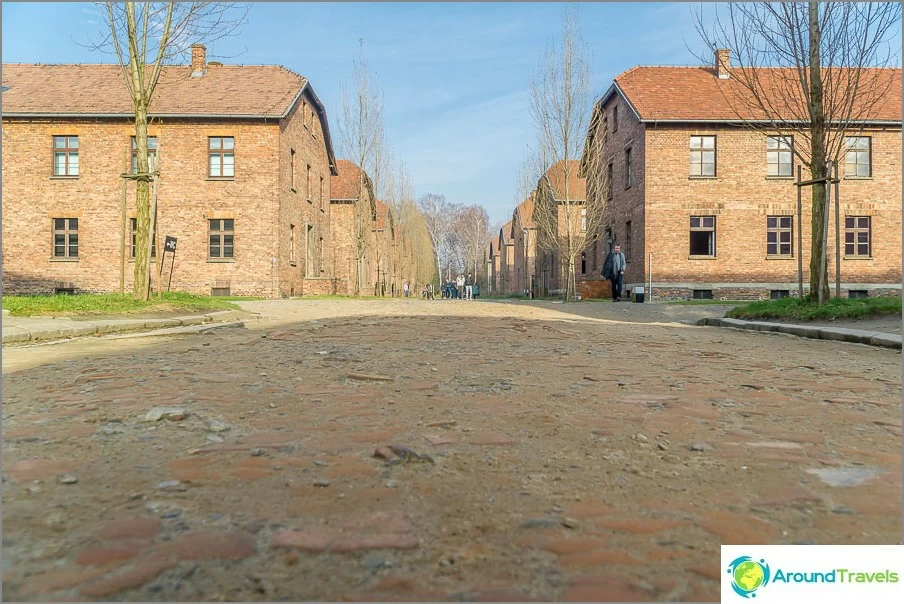
This is what Auschwitz looks like 1

Exposition in one of the barracks Auschwitz 1

This is what most of Auschwitz 2 looks like.
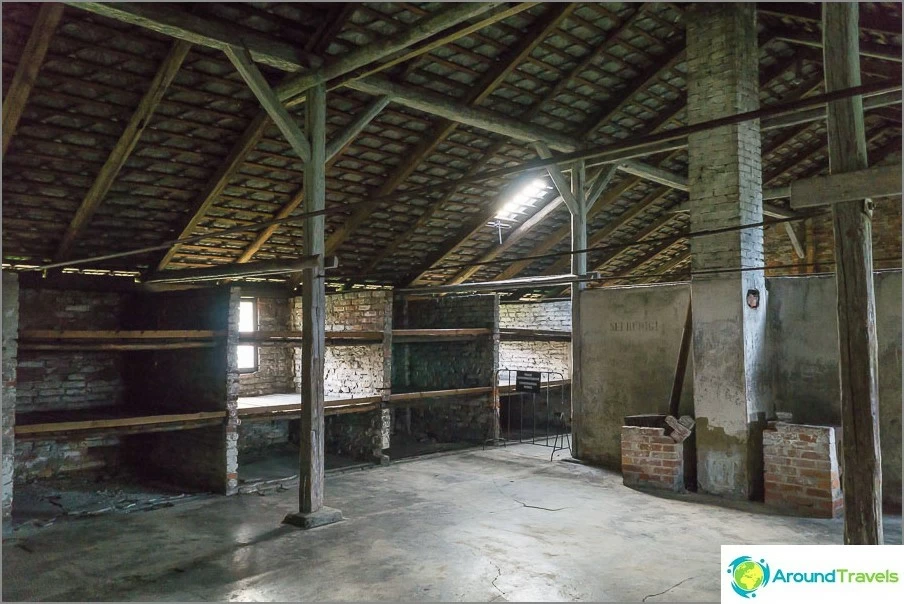
Reconstruction of the barrack in Auschwitz 2
Where to spend the night in Auschwitz
Near the Auschwitz 1 camp (opposite the entrance) there is a good Hotel Olecki, where you can spend the night, either before visiting the concentration camps, or after. It is also convenient because parking is free, there you can leave your car and wander around the sights yourself (if you can call them that).
Working hours
The opening hours of the Auschwitz-Birkenau Museum vary from time of year, or in fact from darkness. When it's dark, there is nothing to do in the camp, and there is almost no lighting..
From April 1st to October 31st from 10.00 to 15.00 entrance to the territory of Auschwitz 1 only as part of excursion groups. Apparently too many people come ... And there are no such restrictions to enter the territory of Auschwitz 2.
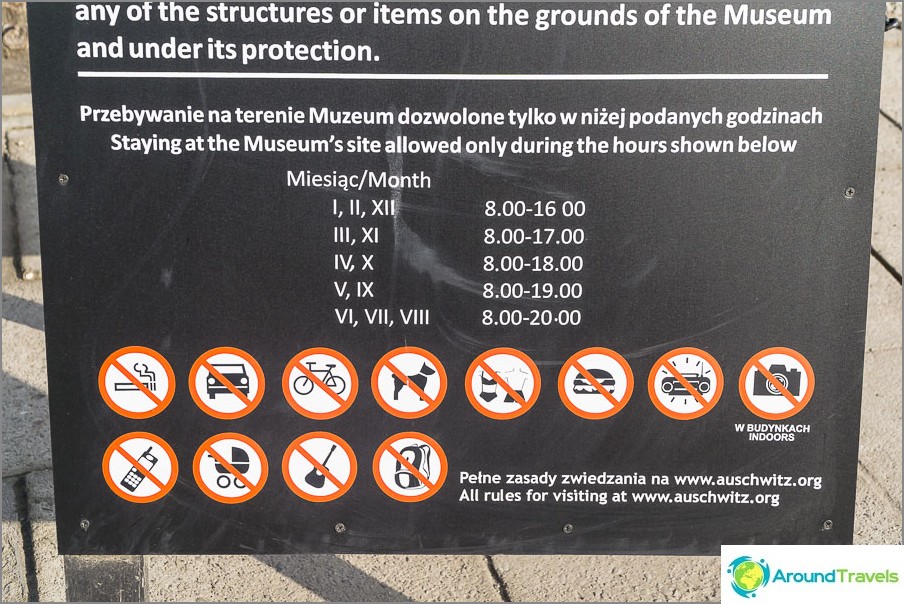
Opening hours of concentration camps in Auschwitz
Excursion to Auschwitz
Time for everything about everything should be laid at least 4-5 hours, or even more, if you really want to see everything. I spent about 6.5 hours and almost had enough. Despite the fact that the first camp is smaller, I stayed there longer, because there is more to see. In the second camp, I walked more, overcoming distances. Take comfortable shoes, you will have to walk a lot (especially if you go for the second).
With an excursion, the visit will be much faster, because the guide leads only through some objects. You will also learn a lot of interesting things, that is, you do not have to read the Internet in advance. But during the excursion, it seems to me, there are much less chances to penetrate, because everything is pretty fast. In an amicable way, either read in advance and use the map on the spot without taking a guide, or take a guide and then take a walk without him.
Group tours are conducted mainly in English and Polish, every half hour / hour, depending on the time of the year (from November to March less often). There is only one group excursion in Russian at 11.30, it runs from May to August and costs PLN 40 per person. However, you can order an individual excursion (2 months in advance on the site's office), it costs PLN 250 per group, you can choose different times, you can be up to 10 people. The tour takes about 3.5-4 hours. During the excursion, you will be given headphones through which you will hear everything that the guide says, even if he is walking somewhere ahead and does not turn his face to you, it is convenient.
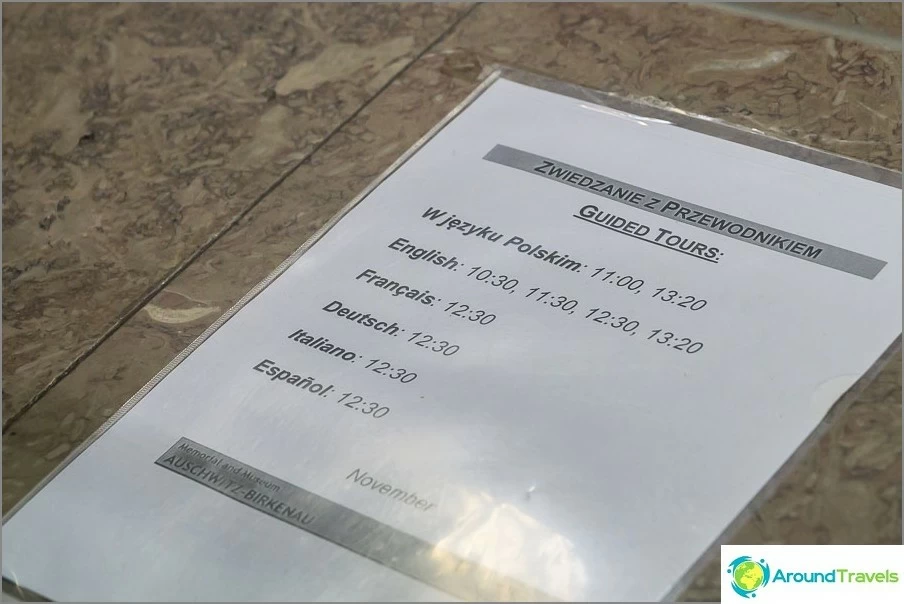
Time for excursions to Auschwitz. Russians are rare here, so only to order
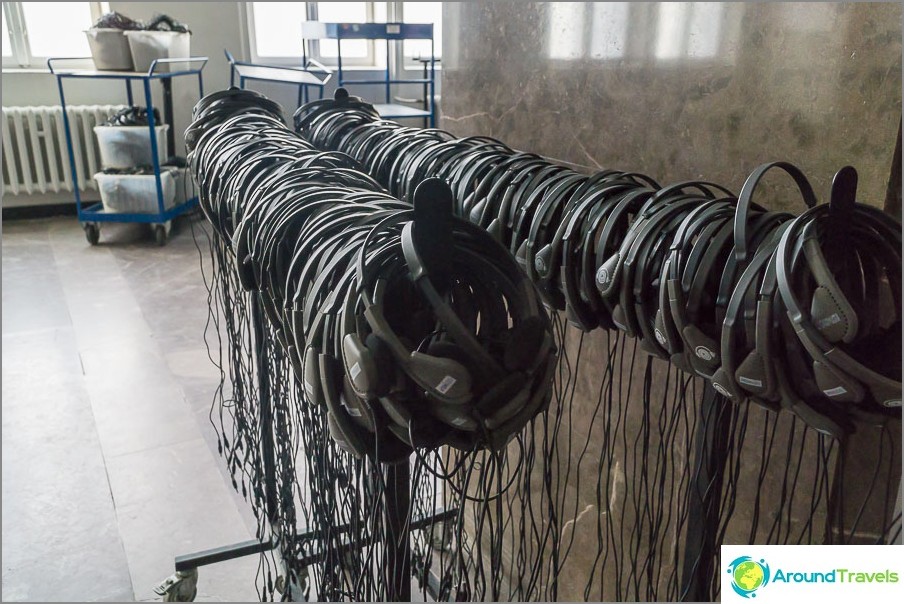
Headphones for a tour of the Auschwitz concentration camp
Visit cost
The entrance to the museum is free, either to the first camp or to the second. But paid parking near each camp, toilets, luggage storage, excursions.
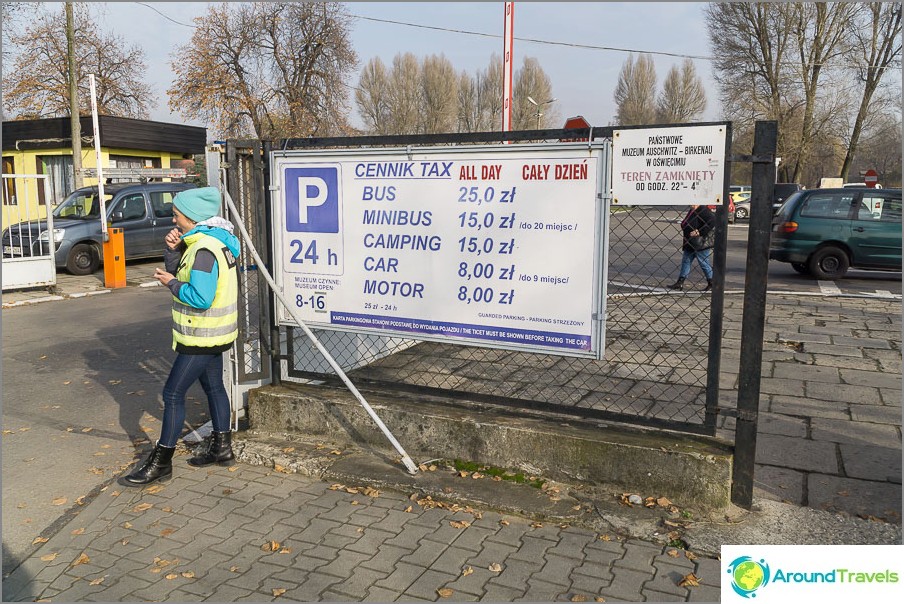
Parking cost near Auschwitz 1
Luggage storage costs 3 pln. You cannot carry something larger than a handbag (30x20x10). And with backpacks they are not allowed even with city ones, you can only go through if they do not notice. Luggage storage is located in Auschwitz 1, that is, it makes sense to start from this camp, leave your things there, then go to Auschwitz 2, and then return. In November, the luggage room was open from 8 a.m. to 5 p.m., I suppose, in other months it works longer, like the museum itself.
A free shuttle bus runs between Auschwitz 1 and Auschwitz 2. Travel time 10 minutes, runs every 15 minutes in the daytime, and every 30 minutes in the morning and evening. Drive about 2.5 km, that is, you can walk on foot.
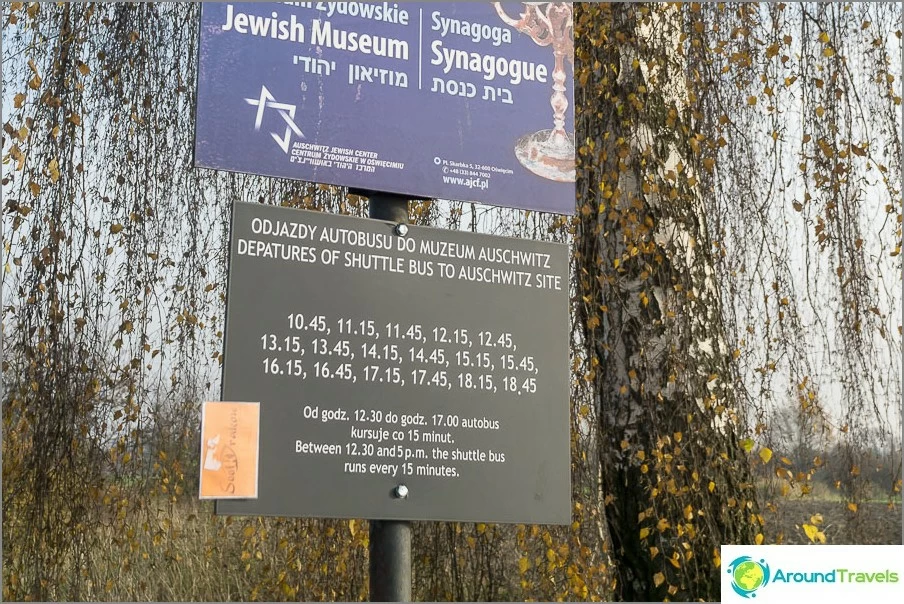
The bass shuttle runs every 15 minutes between 12:00 and 17:00
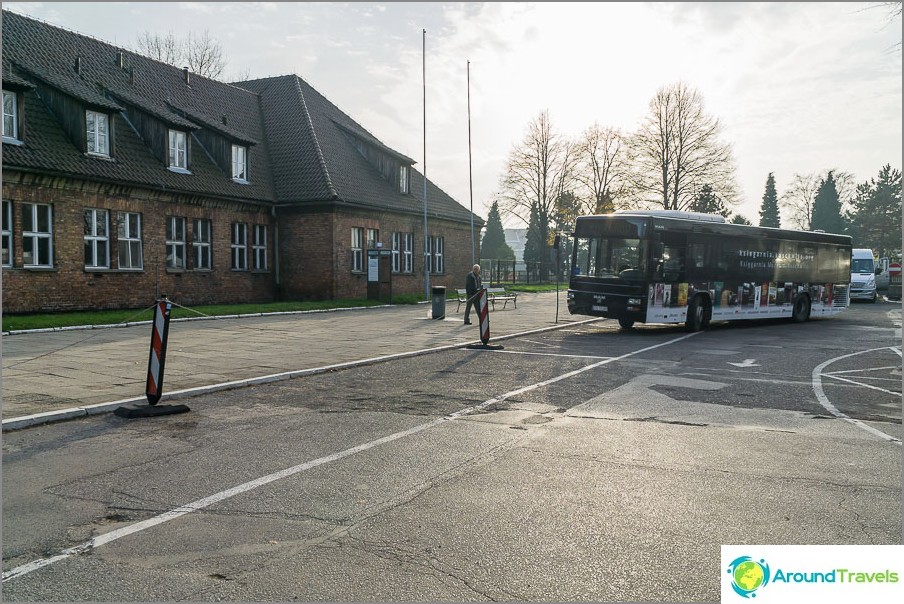
Shuttle bus stop at Auschwitz parking lot 1
Where to have a snack
At the entrance to Auschwitz 1 they sell water, sandwiches and other snacks, Auschwitz 2 has a cafe in the parking lot. Although I would not say that I really want to eat. There are also a couple of grocery stores and cafes right opposite the Auschwitz train station. And not far from it, a 10-minute walk, there is a large shopping center with Carrefour.
Auschwitz Map
Maps are clickable, large images open.
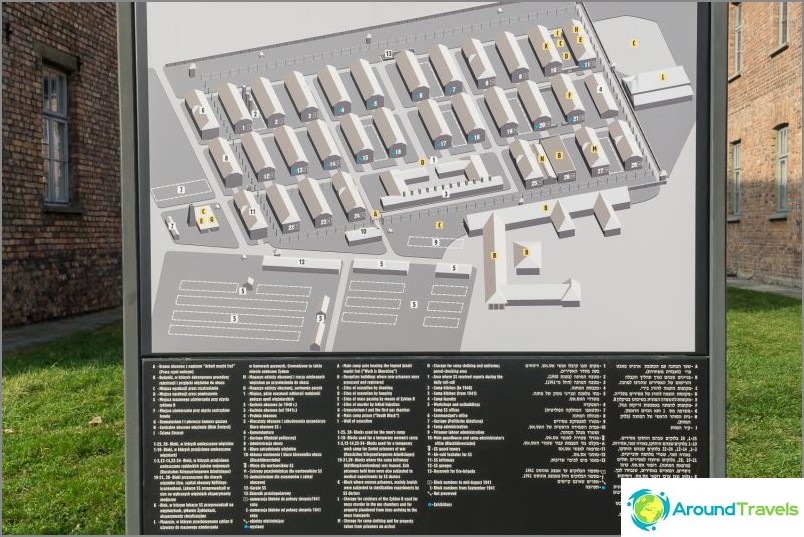
Ovencim Concentration Camp Map (Auschwitz I)

Auschwitz-Birkenau concentration camp map (taken from ushmm.org, but this is unlikely to be the source)
How to get to Auschwitz
In order not to repeat myself, I'll just give you link to post, where I described several options for how you can get to Auschwitz on your own. Naturally, if you are in a car, then this is not relevant to you, just put a point in the navigator and go. Map below to help.
Where is Auschwitz
Concert Auschwitz 1:
Concert Auschwitz 2 (Auschwitz-Birkenau):
Train station in Auschwitz:
Railway station in Katowice:
Railway station in Krakow:
Bus station in Krakow:
Bus station in Katowice:
Bus station in Auschwitz:
Hotel Olecki:
P.S. One of the longest in writing posts, but not because the text itself took a long time to write, but because I read various stories about Auschwitz, autobiography, watched videos and films.
P.P.S. When I wrote «nothing» and «emptiness» I meant that I want to automatically fence myself off from this. But in the end, all the same for a long time, all these pictures stand in front of my eyes, and the thought itself returns to what happened..
